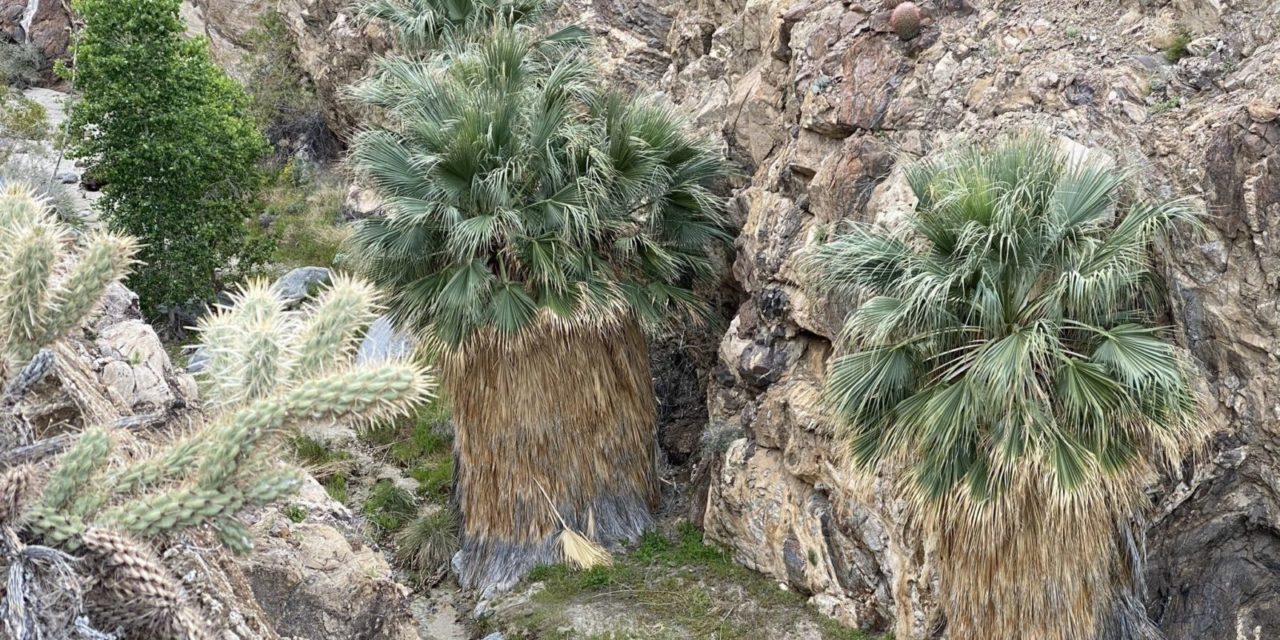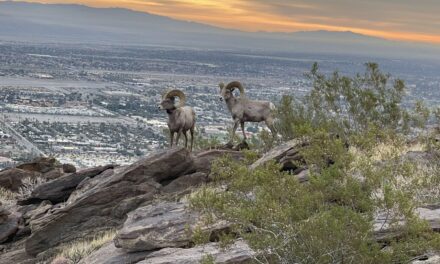Thanks to the coronavirus, hiking spots are difficult to find these days in and around the Coachella Valley. Joshua Tree National Park, Coachella Valley Preserve, the Santa Rosa and San Jacinto Mountains National Monument and most other local parks and nature preserves all are closed, and for good reason.
We still can plan future hiking trips, though. Here’s one local route that even if there were no coronavirus you couldn’t do until Oct. 1 anyway.
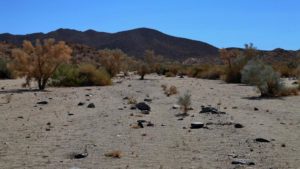
The Carrizo Canyon Trail begins in a large wash.
You can see endangered bighorn sheep and fascinating rock formations on the Carrizo Canyon Trail near Palm Desert.
The 2.7-mile trail preserves a breeding ground and longtime water supply for peninsular bighorn sheep on 1000-acre Carrizo Canyon Ecological Reserve run by the California Department of Fish and Wildlife. Gaining 413 feet in elevation, the canyon leads to a waterfall and an overlook of the Coachella Valley. It is only open Oct. 1 to Dec. 31.
To reach the trailhead, from Calif. Hwy. 111 in Palm Desert, take Calif. Hwy. 74 (the Pines to Palms Highway) south into the mountains. Turn right/west into the Art Smith Trailhead parking lot.
The trail leaves from the western lot’s southern side, crossing a wide open wash. Water rushing down the Carrizo Canyon to the south and Dead Indian Canyon to the west formed the wash.
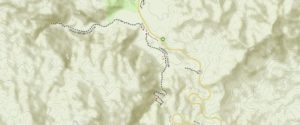
Carrizo Canyon Trail topo map
Creosote bush scrub dominates the sandy area. The wide variety of creosote bush species are a common sight across the Southwest, as they cover much of the desert floor and the flat alluvial fans of the Mojave, Sonoran and Chihuahuan deserts. In the Coachella Valley, the Coahuilla Indians traditionally used the local variety for intestinal issues and tuberculosis.
After a mile, the wash and its soft sands give way to narrow Carrizo Canyon. Some of the Coachella Valley’s most interesting geologic wonders can be seen here, thanks to the intermittent stream carving through the mountainside. Colorful rock walls abound but most spectacular are the large twists and turns of the rocks as they’ve been folded and refolded over millions of years. These formations formed as the Pacific and North American tectonic plates slid against one another, just a few miles to the east at the San Andreas Fault.
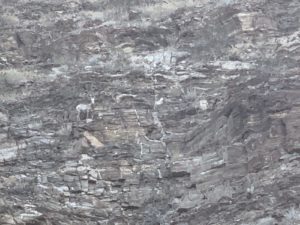
An endangered bighorn sheep blends in almost perfectly on its cliffside perch along the Carrizo Canyon Trail.
Keep an eye out for the bighorn sheep on cliffs overlooking the canyon. About 950 bighorn sheep live in the mountains surrounding the Coachella Valley. They blend in quite well with the tawny landscape, but their size gives them away. Adult rams can weigh between 150-200 pounds – as much as a full-grown man – and ewes usually are 100-125 pounds. The adult ram’s horns sometimes reach 30 inches each in length and at the base are 15 inches in circumference.
Bighorn often can be seen feeding on acacia, encelia, krameria and sweetbush, but they will adapt their diet to what’s available. Indeed, some bighorn have migrated onto golf courses where they browse on the greens and drink from water hazards.
Lambs usually arrive in January-June, with most births in February-April. Sometimes parts of the trail are closed during birthing season. Golden eagles will prey upon the younger lambs; coyotes, mountain lions and wolves are the bighorn’s main predators.
If you don’t spot any bighorn sheep, don’t fret. There are plenty of other animals in the canyon, including mule deer, coyote, bobcat, gray fox, Gambel’s quail, mourning dove, and the black-throated sparrow. You’ll at least spot their tracks and likely hear the birds’ calls.
This section of the trail does require some agility, as you’ll have about a half-dozen climbs over boulders. The boulder fields largely are behind you., though, once you reach a lone palm tree, though.
You’ve also come to a fork in the trail.
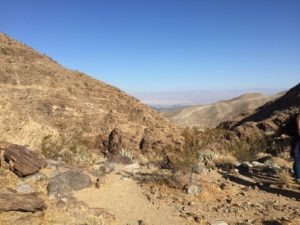
An overlook at end of a fork on the Carrizo Canyon Trail offers a great view of Palm Desert.
Go left/southwest first. This heads to an overlook with a nice view of Coachella Valley and a tucked away palm oasis. Palm Desert takes up most of the view with the hills of the Coachella Valley Preserve just behind it. The brown mountains rising beyond that are the Little San Bernardinos, which forms the Coachella Valley’s eastern wall.
Return to the lone palm tree and go right/southwest at the fork for a short walk to a seasonal waterfall. It’ll be dry in autumn with the waterway running through the canyon at best a trickle, but you can spot a lot of animal prints in the sand. If agile enough to climb up the roughly 12-foot waterfall, the trail continues to that small oasis of California fan palms.
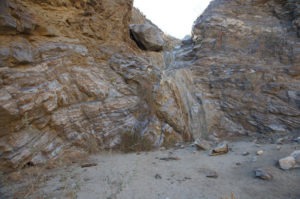
A dry waterfall sits at the end of a fork on the Carrizo Canyon Trail.
Once you’ve taken in the waterfall or the oasis, retrace your steps back to the parking lot.
If you feel more comfortable hiking with others, be sure to check out the Thursday morning hikes offered in November and December by the Friends of the Desert Mountains. Volunteer trail guides offer a plethora of information about the canyon, help you search for wildlife, and even point out an Indian grinding stone.
If rain is falling, forecast or fell during the past day in the higher elevations, do not hike this trail, as flash flooding can occur. Always bring your own water and do not drink from the stream should it be flowing. Dogs also are prohibited on the trail, as canines – seen as predators – cause unnecessary stress to bighorn sheep.
Lead photo caption: A small palm oasis rises in the canyon just behind the waterfalls.
08 Carrizo Canyon Trail topo map
Image Sources
- 03-an-endangered-bighorn-sheep-blends-in-almost-perfectly-on-its-cliffside-perch-along-the-carrizo-canyon-trail.: Rob Bignell
- An overlook: Rob Bignell
- A small palm oasis rises in the canyon just behind the waterfalls.: Rob Bignell

